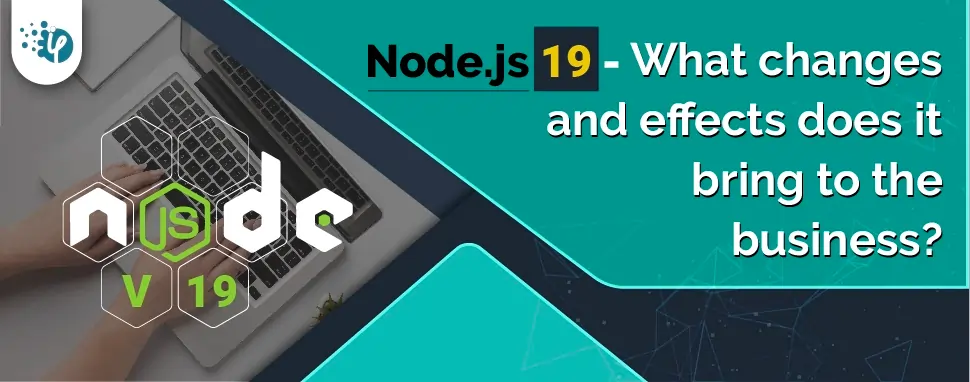Modernizing applications with the 7 R strategy – A CTO’s Guide
Think about the last time CTOs spent most of their time fixing old systems. Updates were slow, servers were expensive, and adding new features took time. Now, things have changed....
Listening is fun too.
Straighten your back and cherish with coffee - PLAY !

Node is an open-source JavaScript run-time environment based on the V8 JavaScript engine. When it comes to developing quick and scalable apps, it has always been the first choice of developers. This is because NodeJS is lightweight and employs an event-driven, non-blocking paradigm. It also includes JavaScript module libraries that make developing real-time applications easier.
Node.js applications are highly fast and scalable. This is due to the extensive support for asynchronous and single-threaded IO models, rapid advancements, and decreased code with enhanced performance. The Node community is committed to its processes and introduces something amazing with each new release. For example, the most recent Node v18 release included fantastic updates such as ECMA script improvements, web streams API, etc.
Node v18 was recently introduced, and we know how well it fared among app developers. Node.js 19 is now available, just six months after the last version was released. Node v19 is expected to include significant improvements to features that were lacking in Node 18, making it even more appealing to tech enthusiasts and businesses.
Some major changes that come with Node v19 are -
Upgrading to Node 19 will provide you with at least three years of peace of mind. Yes, Node.js v19 comes with major changes that ensure better performance and help deliver sustainable applications.
With the release of the new Node version, the APIs or packages that were built as experimental gain support and become stable versions. Every two weeks, Node v19 will have a new publish, thus, you can stay up to date on the most recent modifications and features.
Node.js introduces some exciting changes with its every update. The same goes for Node version 19.
Node.js v19 continues to reduce the gap between the server and the browser. It is good news for developers who want to work as full-stack developers without having to switch languages.
Before Node v19 restarts the server whenever there is a change in code needs to manually restart the code. Or need an additional tool known as a nodemon to automatically restart the server.
Now, with node v19 there is no requirement for an additional tool. Instead, we can use node - - watch that will automatically restart the application when file changes are detected.
const express = require('express');
const path = require('path');
const app = express();
app.use(express.static(path.join(__dirname, '../build')));
app.listen(8080, () =>
console.log('Express server is running on localhost:8080')
);
The output will be like this:
The WebCrypto API provides an interface to build the systems using cryptography. With node v19 this API is stable. But some algorithms are exceptions like Ed25519, X25519, X448, and Ed448.
This module can be implemented in two ways:
const { subtle } = globalThis.crypto;
(async function () {
const keyObject = await subtle.generateKey(
{
name: 'HMAC',
hash: 'SHA-256',
length: 256,
},
true,
['sign', 'verify']
);
console.log('key :', keyObject);
const enc = new TextEncoder();
const encodedMessage = enc.encode('I love pizza');
console.log('message :', encodedMessage);
const digest = await subtle.sign(
{
name: 'HMAC',
},
keyObject,
encodedMessage
);
console.log('digest :', digest);
})();
Now, if we run the server the output will:
key = CryptoKey {
type: 'secret',
extractable: true,
algorithm: { name: 'HMAC', length: 256, hash: [Object] },
usages: [ 'sign', 'verify' ]
}
message = Uint8Array(15) [
73, 32, 108, 111, 118,
101, 32, 99, 117, 112,
99, 97, 107, 101, 115
]
digest = ArrayBuffer {
[Uint8Contents]: <30 01="" 13="" 1a="" 1d="" 2f="" 36="" 38="" 49="" 4f="" 55="" 5c="" 5d="" 6b="" 7a="" 82="" 89="" 90="" 9e="" a0="" bc="" cc="" d1="" d7="" d8="" d9="" dd="" de="" e2="" fb="">,
byteLength: 32
}
Node version 19 offers support for the latest version of Google V8 JS engine 10.7. It helps in terms of the development project being updated with JavaScript features and improves the performance.
The V8 JavaScript engine is the runtime environment that executes JavaScript code, it helps developers as they do not need to worry about the platform like whether it will work on Linux, Windows, macOS, or hardware.
Node.js has removed the –experimental-specifier-resolution flag with the release of v19, as the same functionality, can be achieved with the use of a custom loader.
DTrace is used to get a comprehensive view of the current system, which includes memory, CPU time, filesystem, and network utilized by the current process.
DTrace is a useful tool but it requires much work. That is the reason why node.js no longer supports DTrace/SystemTap/ETW in v19.0.0.
The priority of the resources is the key. Maintaining support’s complexity is not worth it without a proper strategy for supporting this.
Node.js 19 sets this true by default. It means that any outgoing HTTP(s) connection will by default use HTTP 1.1 keepAlive. The default duration is 5 seconds.
Enable keepAlive will give better performance and output as the connection will automatically be reused.
And the agent is also able to parse the response keepAlive that the server might send. It helps the client side to find how much time the connection will stay alive.
And the server will automatically disconnect idle clients when the close() method is called.
With the release of Node.js v19, Node.js v18 is now upgraded to LTS, making it ready for Production.
We know that all of the main versions are current for the next six months. However, as an application developer, it is vital to understand the latest three major Node versions, namely Node 18, Node 17, and Node 16, as well as the primary modifications and what has been introduced to make the application extremely performant.
Node.js version 18 is given the codename of ‘Hydrogen’.
Major features of Node v18:
1) Upgrade of the V8 engine to 10.1:
Node.js uses a V8 JavaScript engine in the background, making JavaScript code compilation into native machine codes easy. And it also improves the performance of server applications.
In node v18, the V8 engine is upgraded to 10.1 which is part of chromium 101.
There are also new methods available in Node v18:
2) Global Fetch Enable by Default:
Fetch API is one of the most used to make an HTTP request on the web. Before node v18 developers need to install the packages to get responses from APIs and fetch the data.
In previous versions of the node to make HTTP requests, it needed the use of XMLHttpRequest API, and it increases the number of lines in terms of coding.
3) Core Test Runner Module:
Before node v18 there was no test runner available in the node. From v18 the test runner module will be available using the node: prefix.
With this implementation, there is no need for external packages for test runners from now on.
The node: test module helps in the easy creation of JavaScript tests that return output in TAP format.
Major features in Node.js version 17:
1)More Promisified APIs:
It is a continuous initiative within the node project to provide promised-based node.js core APIs. In node v15 Timers Promises APIs and Streames Promises APIs were added.
In node v17, new promise-based APIs were added for the Readline module. It provides an interface to read data from a Readable Stream one line at a time.
2)Stack traces with Node.js version:
Stack traces are an important part of diagnosing errors, to help developers to find what went wrong. In node v17, the version of the node will be displayed at the end of the stack traces where fatal errors stop the execution.
Major features in Node.js version 16:
Node version 19 has brought tremendous updates over v18, however, it won’t be converted into the LTS version due to the odd number series. Still, it is good to play around with NodeJS v19 as it helps with performance improvement.
We created this blog to help you understand the Node.js 19 improvements and their implications for application development. Thank you for taking the time to read this article. If you have any questions or searching for a reputed Node.js application development company, do not hesitate to contact us.

Think about the last time CTOs spent most of their time fixing old systems. Updates were slow, servers were expensive, and adding new features took time. Now, things have changed....

According to HackerOne, fixing a security issue after software is released can cost 30 times more than fixing it during development. Today, CTOs take a different approach. Shift...

A few years ago, companies built software first and thought about security later. Developers and security teams did not cooperate, and problems were fixed only after release. This activated DevSecOps vulnerabilities and many DevSecOps failures.